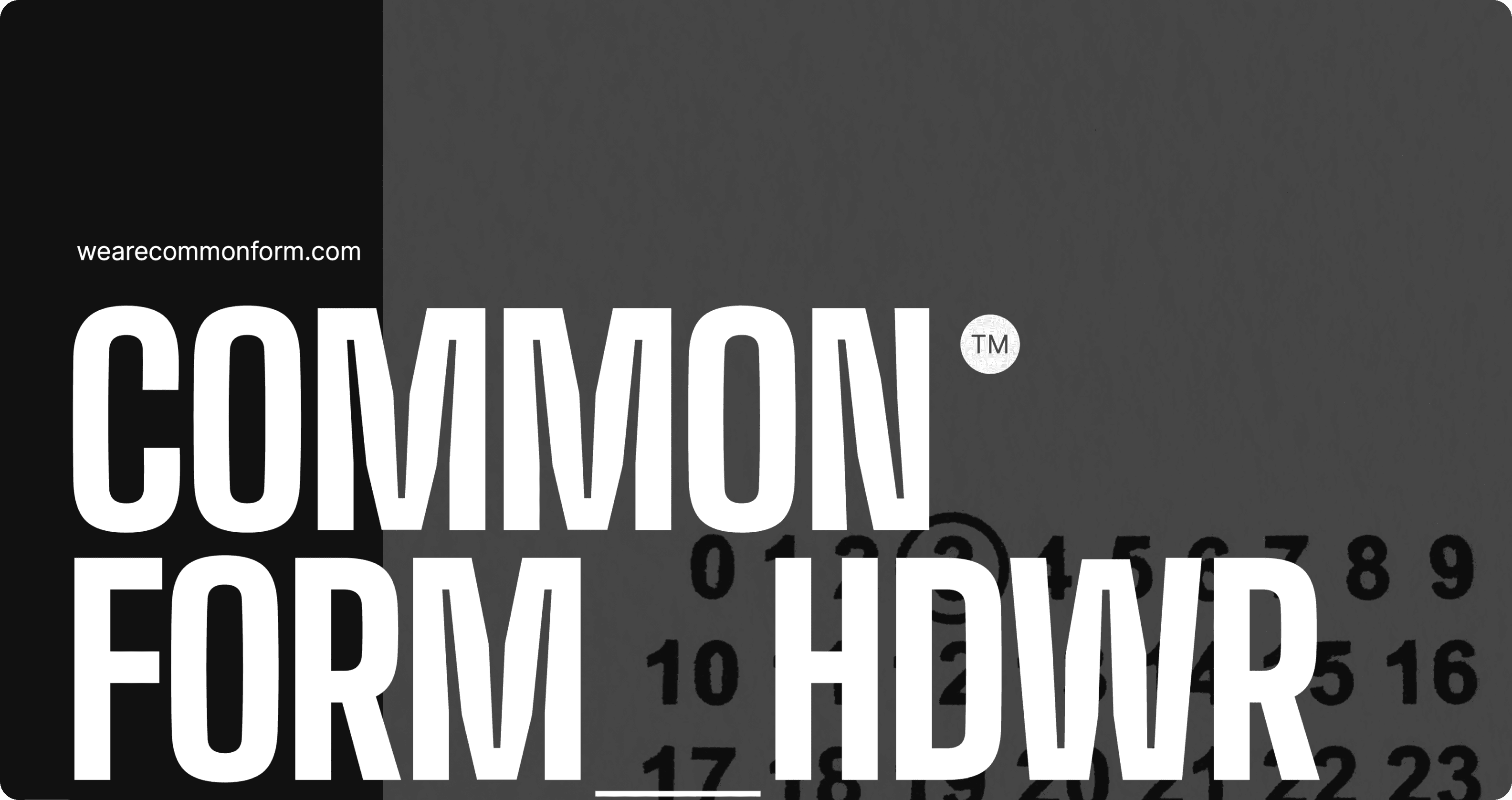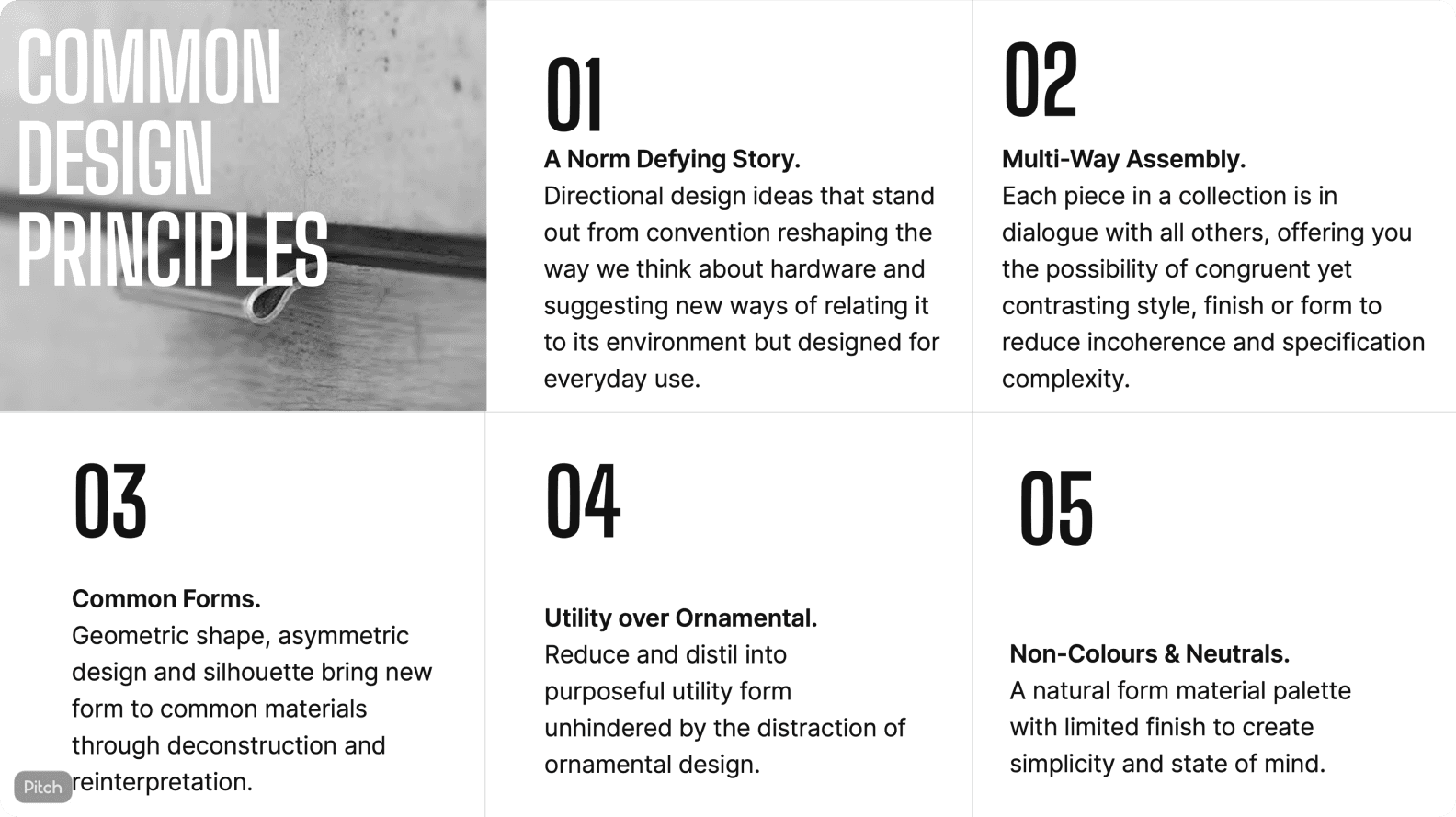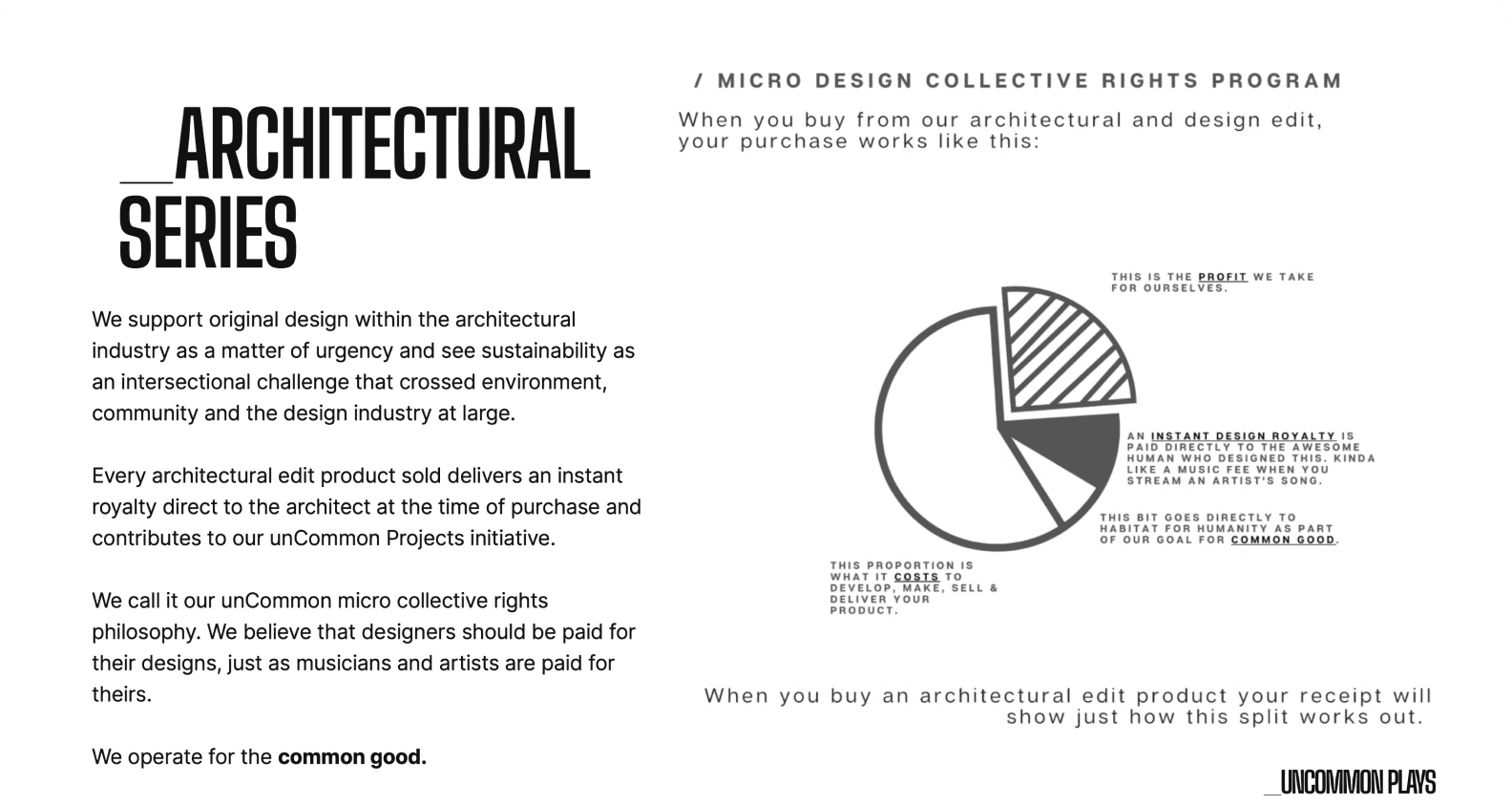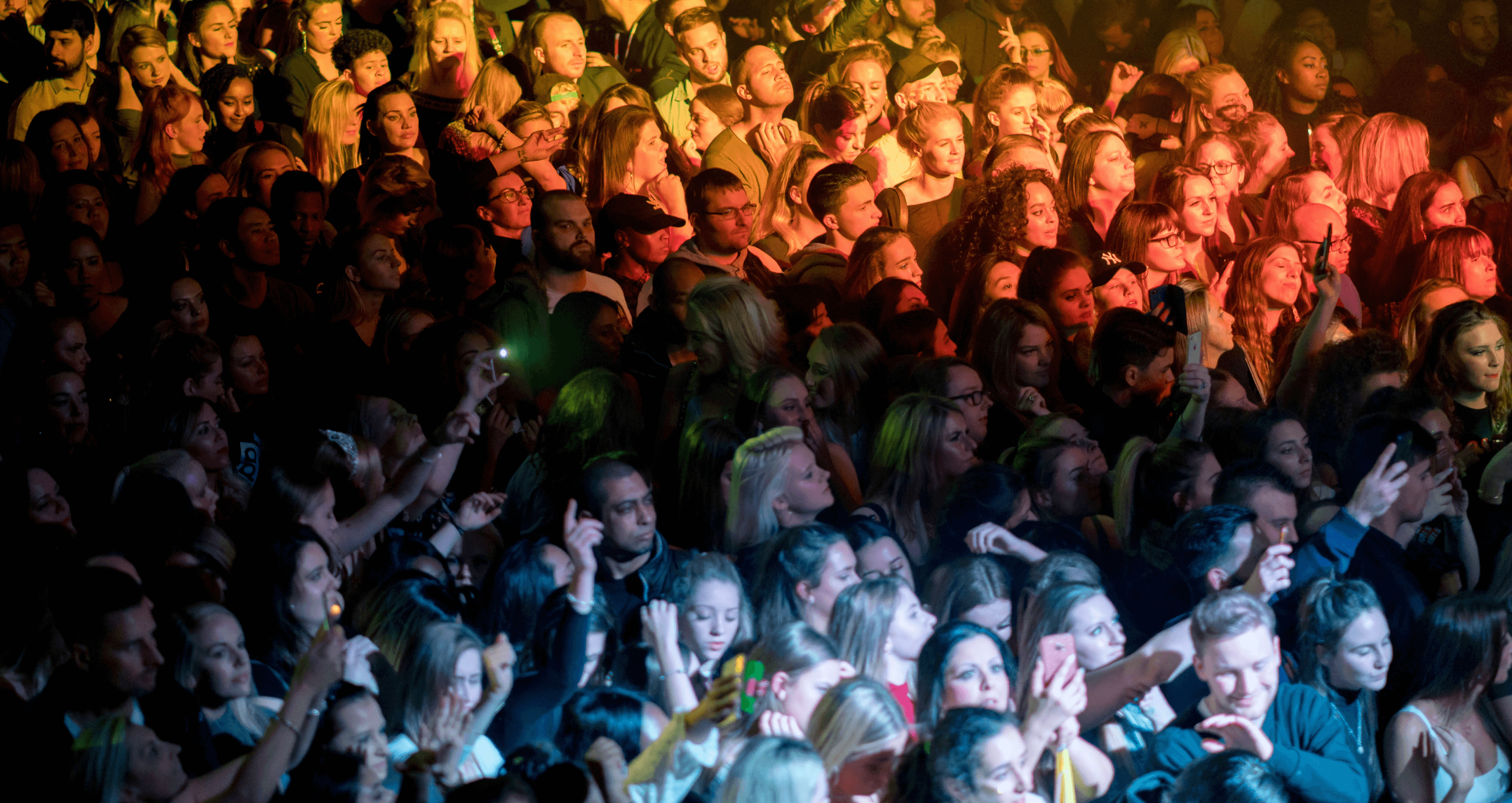Commonform
The radical transformation of a small global architectural hardware design niche.

Concept Development
2021



An UnCommon Market Narrative
We live in an age of global inspiration and unlimited choice. And it's harder than ever to find hardware that feels like us. With so much change happening so rapidly, markets are shifting and the usual suspects are being disrupted by fast-moving and focused startups.
A question we ask ourselves during the early stages of thinking about this new model is: Could this be impactful if it worked? What market constraints or rules of play don't make sense anymore? Where is there opportunity to zig when others zag? We find that a good test is whether we can articulate why most people think it's a bad idea, but we understand what makes it good. A starting point for us was . . . what important problems or opportunities are there in this category, and why is no one working on them? Answering this well requires a combination of thinking independently, reasoning about what the future market might look like, and identifying attack vectors.
#shifthappens

An UnCommon View
Aesthetics are never just about design. Our aesthetic predispositions also intrude into what we believe to the domains of reason. We rely on aesthetic cues to determine how we feel about something or, whether the information we receive from someone is true, false or in between. Our susceptibility to 'honest' eyes, a 'sincere' tone of voice, 'solid' facts or an 'elegant' argument suggests that even the foundations of our rational knowledge are subject to aesthetic mediation.
When we think about product design, our approach to aesthetics and a reinterpretation of common materials and form, provides a narrative with which we might rethink this space. The serial nature of the factory assembly line has meant that the production of goods, mass produced for commercial purpose has changed the nature of what it means to design. This new reality of mass production technique has helped to eradicate the time honoured traditions of the hand crafted, custom made artisan methods we saw in the production of local goods made on a smaller scale.
And although the design mantra Form Follows Function or 'format begat form' is indicative of this shift, the urgency we feel to return to products with soul . . has never been more apparent.
How might we think about the interplay of texture, edge, the flow of linear form, symmetry, granularity, colour and shade . . as we step out of this production context? Those architects and designs who choose common materials and forms, reinterpreting them in an attempt to once again provide the ephemeral quality of true craft, seek to recreate the allure of early handmade design.



An UnCommon Market Narrative
We live in an age of global inspiration and unlimited choice. And it's harder than ever to find hardware that feels like us. With so much change happening so rapidly, markets are shifting and the usual suspects are being disrupted by fast-moving and focused startups.
A question we ask ourselves during the early stages of thinking about this new model is: Could this be impactful if it worked? What market constraints or rules of play don't make sense anymore? Where is there opportunity to zig when others zag? We find that a good test is whether we can articulate why most people think it's a bad idea, but we understand what makes it good. A starting point for us was . . . what important problems or opportunities are there in this category, and why is no one working on them? Answering this well requires a combination of thinking independently, reasoning about what the future market might look like, and identifying attack vectors.
#shifthappens

An UnCommon View
Aesthetics are never just about design. Our aesthetic predispositions also intrude into what we believe to the domains of reason. We rely on aesthetic cues to determine how we feel about something or, whether the information we receive from someone is true, false or in between. Our susceptibility to 'honest' eyes, a 'sincere' tone of voice, 'solid' facts or an 'elegant' argument suggests that even the foundations of our rational knowledge are subject to aesthetic mediation.
When we think about product design, our approach to aesthetics and a reinterpretation of common materials and form, provides a narrative with which we might rethink this space. The serial nature of the factory assembly line has meant that the production of goods, mass produced for commercial purpose has changed the nature of what it means to design. This new reality of mass production technique has helped to eradicate the time honoured traditions of the hand crafted, custom made artisan methods we saw in the production of local goods made on a smaller scale.
And although the design mantra Form Follows Function or 'format begat form' is indicative of this shift, the urgency we feel to return to products with soul . . has never been more apparent.
How might we think about the interplay of texture, edge, the flow of linear form, symmetry, granularity, colour and shade . . as we step out of this production context? Those architects and designs who choose common materials and forms, reinterpreting them in an attempt to once again provide the ephemeral quality of true craft, seek to recreate the allure of early handmade design.



An UnCommon Market Narrative
We live in an age of global inspiration and unlimited choice. And it's harder than ever to find hardware that feels like us. With so much change happening so rapidly, markets are shifting and the usual suspects are being disrupted by fast-moving and focused startups.
A question we ask ourselves during the early stages of thinking about this new model is: Could this be impactful if it worked? What market constraints or rules of play don't make sense anymore? Where is there opportunity to zig when others zag? We find that a good test is whether we can articulate why most people think it's a bad idea, but we understand what makes it good. A starting point for us was . . . what important problems or opportunities are there in this category, and why is no one working on them? Answering this well requires a combination of thinking independently, reasoning about what the future market might look like, and identifying attack vectors.
#shifthappens

An UnCommon View
Aesthetics are never just about design. Our aesthetic predispositions also intrude into what we believe to the domains of reason. We rely on aesthetic cues to determine how we feel about something or, whether the information we receive from someone is true, false or in between. Our susceptibility to 'honest' eyes, a 'sincere' tone of voice, 'solid' facts or an 'elegant' argument suggests that even the foundations of our rational knowledge are subject to aesthetic mediation.
When we think about product design, our approach to aesthetics and a reinterpretation of common materials and form, provides a narrative with which we might rethink this space. The serial nature of the factory assembly line has meant that the production of goods, mass produced for commercial purpose has changed the nature of what it means to design. This new reality of mass production technique has helped to eradicate the time honoured traditions of the hand crafted, custom made artisan methods we saw in the production of local goods made on a smaller scale.
And although the design mantra Form Follows Function or 'format begat form' is indicative of this shift, the urgency we feel to return to products with soul . . has never been more apparent.
How might we think about the interplay of texture, edge, the flow of linear form, symmetry, granularity, colour and shade . . as we step out of this production context? Those architects and designs who choose common materials and forms, reinterpreting them in an attempt to once again provide the ephemeral quality of true craft, seek to recreate the allure of early handmade design.



An UnCommon Market Narrative
We live in an age of global inspiration and unlimited choice. And it's harder than ever to find hardware that feels like us. With so much change happening so rapidly, markets are shifting and the usual suspects are being disrupted by fast-moving and focused startups.
A question we ask ourselves during the early stages of thinking about this new model is: Could this be impactful if it worked? What market constraints or rules of play don't make sense anymore? Where is there opportunity to zig when others zag? We find that a good test is whether we can articulate why most people think it's a bad idea, but we understand what makes it good. A starting point for us was . . . what important problems or opportunities are there in this category, and why is no one working on them? Answering this well requires a combination of thinking independently, reasoning about what the future market might look like, and identifying attack vectors.
#shifthappens

An UnCommon View
Aesthetics are never just about design. Our aesthetic predispositions also intrude into what we believe to the domains of reason. We rely on aesthetic cues to determine how we feel about something or, whether the information we receive from someone is true, false or in between. Our susceptibility to 'honest' eyes, a 'sincere' tone of voice, 'solid' facts or an 'elegant' argument suggests that even the foundations of our rational knowledge are subject to aesthetic mediation.
When we think about product design, our approach to aesthetics and a reinterpretation of common materials and form, provides a narrative with which we might rethink this space. The serial nature of the factory assembly line has meant that the production of goods, mass produced for commercial purpose has changed the nature of what it means to design. This new reality of mass production technique has helped to eradicate the time honoured traditions of the hand crafted, custom made artisan methods we saw in the production of local goods made on a smaller scale.
And although the design mantra Form Follows Function or 'format begat form' is indicative of this shift, the urgency we feel to return to products with soul . . has never been more apparent.
How might we think about the interplay of texture, edge, the flow of linear form, symmetry, granularity, colour and shade . . as we step out of this production context? Those architects and designs who choose common materials and forms, reinterpreting them in an attempt to once again provide the ephemeral quality of true craft, seek to recreate the allure of early handmade design.



An UnCommon Market Narrative
We live in an age of global inspiration and unlimited choice. And it's harder than ever to find hardware that feels like us. With so much change happening so rapidly, markets are shifting and the usual suspects are being disrupted by fast-moving and focused startups.
A question we ask ourselves during the early stages of thinking about this new model is: Could this be impactful if it worked? What market constraints or rules of play don't make sense anymore? Where is there opportunity to zig when others zag? We find that a good test is whether we can articulate why most people think it's a bad idea, but we understand what makes it good. A starting point for us was . . . what important problems or opportunities are there in this category, and why is no one working on them? Answering this well requires a combination of thinking independently, reasoning about what the future market might look like, and identifying attack vectors.
#shifthappens

An UnCommon View
Aesthetics are never just about design. Our aesthetic predispositions also intrude into what we believe to the domains of reason. We rely on aesthetic cues to determine how we feel about something or, whether the information we receive from someone is true, false or in between. Our susceptibility to 'honest' eyes, a 'sincere' tone of voice, 'solid' facts or an 'elegant' argument suggests that even the foundations of our rational knowledge are subject to aesthetic mediation.
When we think about product design, our approach to aesthetics and a reinterpretation of common materials and form, provides a narrative with which we might rethink this space. The serial nature of the factory assembly line has meant that the production of goods, mass produced for commercial purpose has changed the nature of what it means to design. This new reality of mass production technique has helped to eradicate the time honoured traditions of the hand crafted, custom made artisan methods we saw in the production of local goods made on a smaller scale.
And although the design mantra Form Follows Function or 'format begat form' is indicative of this shift, the urgency we feel to return to products with soul . . has never been more apparent.
How might we think about the interplay of texture, edge, the flow of linear form, symmetry, granularity, colour and shade . . as we step out of this production context? Those architects and designs who choose common materials and forms, reinterpreting them in an attempt to once again provide the ephemeral quality of true craft, seek to recreate the allure of early handmade design.


Tags
business strategy, brand concept, product architecture,
⚒️ | Figma | Webflow | Pitch
You might also like

Political Notion
Information Architecture

Political Notion
Information Architecture

Neurodiversity Resources
Concept Development

Neurodiversity Resources
Concept Development
🛠️ Tools + Resources